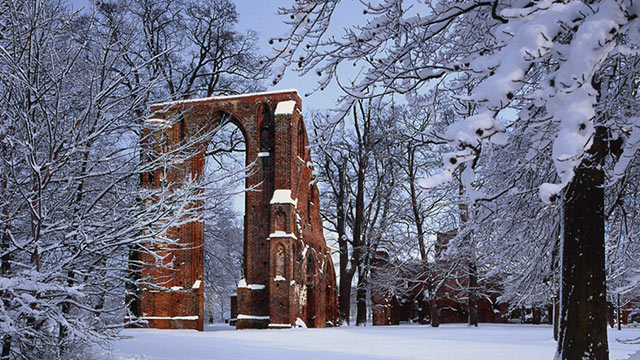
Ruins of Eldena Abbey
The ruins of Eldena Abbey on the outskirts of Greifswald, near the fishing village of Wieck, are an important monument of the Romantic era and probably some of the most famous ruins in Germany. The Brick Gothic Abbey owes its fame to Caspar David Friedrich, whose paintings have made the ruins of Eldena Abbey known worldwide and turned them into a symbol of Romanticism.
The Abbey, whose ruins evoke a great but long lost past, had caught the artist’s imagination from an early point in his career, and they became a frequent subject of his paintings. Friedrich, to whom the ruins represented a symbol of his beloved homeland, studied the Abbey precisely and produced many drawings from different angles, evidence of which can be seen in the ‘Eldena Room’ at the Caspar David Friedrich Centre.
Cistercian monks settled at the site of the former Abbey more than 800 years ago. They founded a monastery in 1199, which played an important role in the formation of settlements in and cultivation of the surroundings. The Abbey was dissolved in 1535, when the Reformation was introduced into Pomerania.
The buildings were severely damaged during the Thirty Years' War and in the 17th and 18th century the bricks were quarried away for the building of fortifications. Nevertheless, the ruins still bear testimony to the Cistercians’ highly developed sense of form and design and remain an invaluable monument of medieval history and architecture. From 1828 to 1832, a park was laid out on the abbey precinct on the basis of designs by the Prussian landscape gardener Peter Joseph Lenné (1789 – 1866). The park is open for visitors all-year round and free of charge.
Even today, the Abbey’s imposing west facade, a view made famous by Friedrich’s paintings, remains the main attraction of the site.
The Abbey in the Oakwood’ (1809/10, Alte Nationalgalerie, Berlin) is probably Caspar David Friedrich’s most famous painting of the ruins of Eldena Abbey.
Very often, Friedrich positioned the ruins in different locations and contexts and with changing moods. Sometimes, the ruins are bathed in bright, friendly light or surrounded by lush vegetation, as, for example, in ‘Ruins of Eldena, near Greifswald’ (1825/25). On other occasions, the ruins appear in a completely different landscape or context, as for example in ‘Eldena Ruins in the Giant Mountains’ (1830/35, Pomeranian State Museum, Greifswald).
Friedrich’s different versions of the ruins can be interpreted in a number of ways. On the one hand, they can be interpreted as metaphors of transience; on the other hand, they can be understood as tributes to former historical greatness or monuments of Christian piety.
Eldena Abbey and the surrounding park are one of the stops on the Caspar David Friedrich Trail.
Source:
Birthe Frenssen, Kai Kornow, Michael Lissok and Detlef Witt
